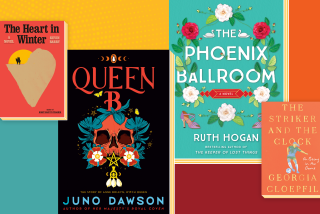Wacky Leno family barbecue
- Share via
If Roast Beef Could Fly
Jay Leno, illustrated by S.B. Whitehead
Simon & Schuster: 32 pp., $17.95
Comedian Jay Leno adapts a family-friendly stand-up bit for this pleasantly silly picture book. Dad, famous for his overblown projects, decides to build a patio deck and a giant barbecue rotisserie in the backyard. After a trip to the “Hardware Supermax store” (“Okay! We need five hundred bricks! Two hundred pounds of cement!” says Dad) and a few months of tinkering, his father unveils the rotisserie.
As a giant roast beef turns on the spit for the Leno family’s end-of-summer barbecue, young Jay’s mouth waters. (“Juice is dripping! Fat is sizzling! ... I’m dying to taste the roast beef.”) Jay whips out his “secret weapon” -- a plastic comb -- and repeatedly steals some drippings with the unorthodox implement. But to Jay’s great dismay, the comb ends up stuck in the roast, prompting a chaotic and funny denouement.
Though many youngsters will miss some of the humor that falls between the lines (which adults will enjoy), the wacky scenario is likely to keep children interested (especially young Jay’s anxious look as he awaits the inevitable). Leno’s talent for storytelling and affection for his family shines through -- especially on his CD recording of the text (packaged with the book).
Illustrator S.B. Whitehead (“Red Foley’s Cartoon History of Baseball”) exaggerates the features and expressions of the characters in his crisply rendered watercolors, in keeping with the farcical tenor of the tale. Period details, from automobiles and clothing to furniture, add flavor. And his likeness of Leno -- basically a miniature version of the TV personality -- is particularly engaging. All ages
*
Halibut Jackson
David Lucas
Knopf: 32 pp., $16.95
Bluebirds wearing crowns soar overhead, pineapples spring from the ground and Indian women draped in saris look on as David Lucas’ (“Shaggy and Spotty”) shy hero triumphs over his fear of being noticed. Halibut Jackson likes “to blend into the background.” Lighthearted, economical ink-and-wash spreads show the hero in camouflage that literally achieves that goal; in one ink-and-wash spread, he leans against a brick wall in town, his huge hat and almost hemispherically shaped coat printed with red and orange bricks.
In another, he stands in front of a library bookshelf, his hat and coat this time striped with book-width bands of color. When Halibut receives an invitation to the palace, he worries about going until it occurs to him to make himself a bejeweled hat and coat to match the palace walls. The event turns out to be a garden party, however, and Halibut stands out like a beacon. But the attention proves agreeable -- everyone begs for a gem-encrusted suit just like his.
“Now Halibut Jackson had friends,” concludes the narrator with satisfaction. “Now Halibut Jackson had plenty to do.” The pure fancy of Halibut’s world distinguishes Lucas’ first solo effort: Blue horses trot through town, trees sprout marvelous fruit and shy chaps named for fish receive invitations from the queen. Halibut may prefer to hide, but kids will immediately recognize the authenticity of his feelings. Ages 3-8
*
The Neighborhood Mother Goose
Nina Crews
Greenwillow/Amistad: 48 pp., $15.99
Nina CREWS’ photographic picture books (“One Hot Summer Day,” “Snowball”) have always captured a certain rhythm -- be it of the playground, a city sidewalk or just childlike interaction. Like them, her latest project rolls along with a strong beat; verse and image keep perfect time. Viewed through Crews’ camera, an urban neighborhood (the author’s beloved Brooklyn, as distinguished by various borough landmarks) resonates with activity.
Readers can almost hear hands clapping, babies cooing and children laughing in crisp photo-collages. A grassy park, storefronts, apartment windows and rooftops provide some of the backdrops for members of a multiethnic cast as they interpret such rhymes as “Ring Around the Rosie,” “Dance, Little Baby” and “Humpty Dumpty.” Crews includes lesser-known verses as well -- “Cobbler, Cobbler,” “Three Wise Men of Gotham” -- which work to equally good effect.
Adding an element of whimsy, she digitally manipulates her photos, achieving a varied scale that allows Jack (of “Be Nimble” fame) to hurdle a cupcake with a candle in it, or three tiny men (those men of Gotham) to head seaward off a Coney Island pier. The updated look provides a freshness without being overtly contemporary; Mother Goose’s timeless rhymes are quite at home in this new setting.
Throughout, the artist demonstrates a talent for coaxing seemingly candid moments from her child subjects as they enact their nursery-rhyme roles, and the other hallmarks of her work -- color, action and a sense of fun -- shine at full force. Ages 3-6
*
Memories of Sun: Stories of Africa and America
Edited by Jane Kurtz
Greenwillow/Amistad: 160 pp., $15.99
Offering 15 unique perspectives of Americans, Africans and African Americans, this collection of vibrant stories and poems celebrates the distinct flavors of the African continent. The first section, titled “Africa,” evokes the beauty of African traditions, landscapes and people. Nikki Grimes captures the magical aura of the Bagamoya seaport in a poem and in a short story that reveals the gentle nature and sense of loss that characterizes the disappearing Bushmen tribes.
The second section of the book focuses on Americans’ first impressions of the continent, crystallizing moments of discovery, awe, confusion and regret. The protagonist of Maretha Maartens’ “The Homecoming” feels out of place living in South Africa until a classmate invites him home and introduces him to his wise grandfather. In the story “Her Mother’s Monkey” by Amy Bronwen Zemser, even though Francine’s father is mostly unsuccessful at treating injured animals during their yearlong stay in Africa, her mother forms a close bond with an orphaned baby monkey.
Though selections in the third and final section of the volume take place on American soil, the rhythm of African life is still strongly felt. Recent exiles such as 15-year-old Kulaja, a former soldier in the African jungle, and Ajang, who had been to missionary school in Khartoum and describes the newness of American culture, struggle to assimilate to a new way of life while retaining a piece of their heritage; another child who has never set foot in Africa gets in touch with her roots through stories handed down by an aunt. Providing sharp, contrasting images of splendor and strife, these selections will reverberate in readers’ minds. Ages 10-older
*
The Outcasts of 19 Schuyler Place
E.L. Konigsburg
S&S;/Atheneum: 304 pp., $16.95
This elegant, absorbing novel focuses on Margaret, half-sister of Connor (the narrator of “Silent to the Bone”) the summer she is 12, in 1983 (long before Connor’s birth). As the novel opens, Margaret’s Hungarian immigrant great-uncle Alex shows up at her summer camp to remove her mid-session and he bests the autocratic camp director as the woman attempts to demonstrate her professionalism and suggests that Margaret is “incorrigible.”
E.L. Konigsburg strikes just the right balance: Uncle Alex, Margaret and, by extension, the audience, are immediately allied against the forces of pomposity and falsehood. En route to the house Uncle Alex shares with his brother (Margaret’s parents, professors, are working in Peru), Margaret, who narrates, lets readers know that she has been bullied by her cabin mates while the camp director has been willfully blind. (The heroine never does tattle.)
Konigsburg’s fans will expect that Margaret is not simply there to be rescued, however, and it is Margaret who ends up making the biggest stand. In their backyard, Uncle Alex and Uncle Morris have built extraordinary towers that have stood for 45 years (the structures inevitably evoke the Towers of Watts); now that their once-abandoned and dangerous neighborhood has been gentrified, the new residents have won a campaign to tear down the towers, arguing that they “don’t fit the [district’s] history.”
These premises lay fertile ground for penetrating discussions about how a culture defines history and art. Though the novel strikes a few uncharacteristically false notes toward the end, the author offers readers so much, so well, that her book is a veritable feast, amply demonstrating how intelligence can triumph over pretense. Ages 10-older
*
Bug Safari
Bob Barner
Holiday: 32 pp., $16.95
“The events described here actually happened to me,” intones the narrator of this “safari” memoir. “The things I learned are recorded to the best of my memory.” But the sober setup is just that -- a lead-in to a romp of a tale with a surprise ending. The artwork is the first clue. Using his trademark eye-poppingly bright cut and torn paper, Bob Barner (“Parade Day”) zooms in on the ground-level action of a trail of black ants.
The narrator, a boy in a pith helmet, is “lost in a bug-infested jungle” and hopes that following the ants will lead him to safety. Crawling amid an explosion of colorful, graphic flowers on vibrant-hued backgrounds, the ants encounter danger from red ants, a toad, a spider -- akin to the boy’s own mock-serious travails: “I had scraped my knees and cut my finger, and needed medical attention. I bravely pressed onward, hoping I would one day see another human being.” Sure enough, the ants do lead him to care and sustenance at the picnic blanket in his own backyard, where he has been roaming all along.
Besides enjoying this roguish adventure, children should pick up a fair amount of insect knowledge (e.g., “I noticed that the ants talked to one another by touching antennae on top of their heads”), especially from the five pages of bug trivia that follow the story. Ages 4-8
*
The Ring of the Slave Prince
Bjarne Reuter, translated from the Danish by Tina Nunnally
Dutton: 376 pp., $22.99
Danish writer Bjarne Reuter (“The Boys From St. Petri”) dishes up a heaping portion of swashbuckling adventure in this 17th century epic. Tom O’Connor, a half-British, half-Irish 14-year-old, helps his mother, a servant at an inn on the Caribbean island of Nevis. An opening scene will pique the audience’s interest with its colorful portrayal of a palm reading, wherein a disreputable fortuneteller finds in Tom a paradoxical blend of nobility, purity and villainy.
He has big dreams of making a fortune by capturing an enslaved prince and releasing him to his father, an African chief. First, however, Tom has to find the prince. Bidding his mother and half-sister goodbye, the young protagonist embarks on a quest, unaware of the dangers that lie ahead. As he journeys through the Caribbean islands on land and by sea, Tom finds treachery, trickery, love and compassion in the most unexpected places. His courage and resourcefulness are tested time and again as he takes on jobs as a blacksmith’s assistant, an overseer at a sugar plantation and a crew member of a Spanish galleon.
Tom emerges as a boy of many contradictions, threatening murder and saving lives in practically the same breath. Readers will stay on the edge of their seats waiting to find out what path he will choose, and whether he ends up a ruthless pirate or celebrated hero. Following the author’s meticulously plotted story line is sheer delight. Ages 12-older
More to Read
Sign up for our Book Club newsletter
Get the latest news, events and more from the Los Angeles Times Book Club, and help us get L.A. reading and talking.
You may occasionally receive promotional content from the Los Angeles Times.





